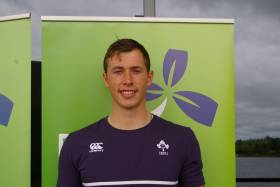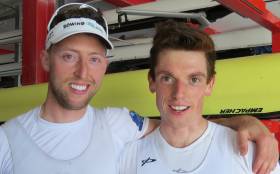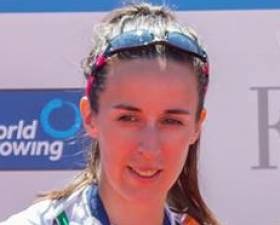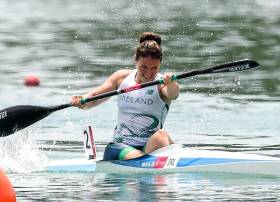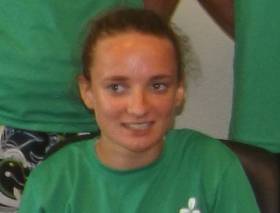Displaying items by tag: World Championships
Repechage Place for Ireland Pair after Sixth in World Rowing Heat
#Rowing: Ireland had to settle for sixth place in the first heat of the men’s pair at the World Rowing Championships in Sarasota-Bradenton in Florida today. The new crew of Fionnán McQuillan-Tolan and Patrick Boomer were never realistic contenders for one of the first two places, which would have sent them directly to the A/B semi-finals. They are now set for a repechage on Tuesday (5.24 or 5.29 Irish time).
Ireland’s three lightweight crews won their heats: single sculler Denise Walsh secured her win with a sprint finish, while Paul O’Donovan and the pair of Mark O’Donovan and Shane O’Driscoll won relatively easily.
World Rowing Championships, Sarasota-Bradenton, Florida – Day One – Irish Interest:
Men
Pair – Heat One (First two to A/B Semi-Final; rest to Repechage): 1 Italy 6:27.88, 2 France 6:33.03; 6 Ireland (F McQuillan-Tolan, P Boomer) 6:50.82.
Lightweight Pair – Heat One (First to A Final; rest to Repechage): 1 Ireland (M O’Donovan, S O’Driscoll) 6:33.20, 2 Britain (J Cassells, S Scrimgeour) 6:38.57, 3 Italy 6:40.39.
Lightweight Single Sculls – Heat Three (First Four to Quarter-Finals; rest to Repechages): 1 Ireland (P O’Donovan) 6:54.68, 2 Brazil 7:05.75, 3 Italy 7:09.88, 4 Thailand 7:17.50.
Women
Lightweight Single Sculls – Heat Three (First Three to A/B Semi-Finals; rest to Repechages): 1 Ireland (D Walsh) 7:43.87, 2 South Africa 7:44.38, 3 Italy 8:03.34.
O'Driscoll and O'Donovan Win Way to A Final at World Championships
#Rowing: Mark O’Donovan and Shane O’Driscoll won their heat to qualify directly for the A Final of the lightweight pair at the World Rowing Championships.
Italy took an early lead, but Ireland took over in the second quarter. Britain challenged but O’Donovan and O’Driscoll won by over five seconds.
World Rowing Championships, Sarasota-Bradenton, Florida – Day One – Irish Interest:
Men
Lightweight Pair – Heat One (First to A Final; rest to Repechage): 1 Ireland (M O’Donovan, S O’Driscoll) 6:33.20, 2 Britain (J Cassells, S Scrimgeour) 6:38.57, 3 Italy 6:40.39.
Ireland and Britain Head-to-Head Early at World Rowing Championships
#Rowing: Mark O’Donovan and Shane O’Driscoll are Ireland’s first crew in action at the World Rowing Championships in Sarasota-Bradenton in Florida on Sunday. The lightweight pair take on Britain, Hungary and Italy – and if they win this heat at 3.10 pm Irish time they go directly to the A Final. Paul O’Donovan’s heat of the lightweight single sculls follows at 3.30 – he will have a more demanding programme, as he will only qualify for a quarter final by taking a top four place.
In quick succession there are heats for the Denise Walsh (4.01) and the men’s pair of Patrick Boomer and Fionnán McQuillan-Tolan (4.11).
The women’s pair, though an Olympic event, has 11 crews. So while Aileen Crowley and Aifric Keogh would have to win their heat (3.46 on Monday) to qualify for the A Final, they know that they have a repechage to come and a guaranteed place in at least the B Final.
Sanita Puspure goes at 4:32 on Monday. She has a tough heat, featuring Switzerland, Latvia and Bahrain, with the winner going to the A/B semi-final.
World Rowing Championships, Sarasota-Bradenton, Florida – Draw – Irish Interest:
Sunday (times Irish; heats)
3:10: Men’s Lightweight Pair – Mark O’Donovan, Shane O’Driscoll (Winner to A Final; rest to Repechages)
3:30: Men’s Lightweight Single Sculls: Paul O’Donovan (First Four to Quarter-Finals; rest to Repechages)
4:01: Women’s Lightweight Single Sculls: Denise Walsh (First Three to A/B Semi-Finals; rest to Repechages)
(Note!) 4:06: Men’s Pair: Patrick Boomer, Fionnán McQuillan-Tolan (First Two to A/B Semi-Finals; rest to Repechages)
Monday
3:46: Women’s Pair: Aileen Crowley, Aifric Keogh (Winner to A Final)
(NOTE!) 5:32: Women’s Single Sculls: Sanita Puspure (Winner to A/B Semi-Final)
RTÉ to Cover Ireland at World Rowing Championships
#Rowing: Teams from 69 nations have travelled to Sarasota-Bradenton in Florida, USA to compete in the 2017 World Rowing Championships. Over 900 athletes will be competing. Unfortunately, one of Ireland’s top medal hopes – the men’s lightweight double sculls crew of Gary and Paul O’Donovan – will not feature as Gary has been forced to withdraw due to illness. Instead, Paul O'Donovan will compete in the lightweight men's single sculls in a bid to retain his title of World Champion.
Mark O’Donovan and Shane O’Driscoll will compete in the lightweight men’s pair, rounding off an incredible year for the crew. They remain unbeaten in this category across the three World Cup events of 2017, as well as taking the title of European Champions. A newly-formed heavyweight men’s pair of Patrick Boomer (Belfast Rowing Club) and Fionnán McQuillan-Tolan (NUIG) will also compete, The Ireland women’s pair comprises Aileen Crowley (UCD) and Aifric Keogh (UCC). The two remaining women’s crews are double Olympian Sanita Puspure of Old Collegians in the women’s single sculls, and 2017 European silver medallist Denise Walsh from Skibbereen in the women’s lightweight single.
RTÉ have confirmed that there will be live coverage of the event from Thursday 28th September on RTÉ2. Joe Stack will be joined in studio by Neville Maxwell and Sinead Lynch (née Jennings), with commentary from Ger Canning and Sam Lynch. Evanne Ní Chuillin will also be reporting from Sarasota.
Coverage begins at the following times:
- Thursday 28th Sept: 3:00pm
- Friday 29th Sept: 4:30pm
- Saturday 30th Sept: 4:30pm
- Sunday 1st Oct: 3:30pm
- Sunday 1st Oct: 8:00pm (Highlights)
Jenny Egan Takes Bronze Medal at World Marathon Championships
#Canoeing: Ireland’s Jenny Egan took a bronze medal in the K1 at the Canoe Marathon World Championships in Pietermaritzburg in South Africa. Lani Belcher, who competes for Britain, took gold at the head of a group of three which broke away from the rest of the field. Vanda Kiszli of Hungary took silver.
Egan’s World Championship medal capped a season in which she won gold and bronze in the K1 5,000 at canoe sprint World Cup events.
Rónán Ó Foghladha took fifth in the men’s junior K1.
Canoe Marathon World Championships, Pietermaritzburg, South Africa (Irish interest)
Men - K1: 19 B Watkins 2:15.26; 24 P Egan 2:19.07. Junior: 5 R Foley 1:45.48.
Women – K1: 1 Britain (L Belcher) 2 hrs 5 min 04 seconds, 2 Hungary (V Kiszli) 2:05.10, 3 Ireland (J Egan) 2:05.39; 17 A Smith 2:17.20
Egan Tenth In Dramatic World Championship Final
#Canoeing: Ireland’s Jenny Egan finished 10th in the women’s K1 5,000 metres at the canoe sprint World Championships in Racice in the Czech Republic today. In a dramatic race, Dora Bodonyi of Hungary came out with the gold medal after a long battle with Tabea Medert of Germany, who took silver. Lani Belcher of Britain gritted it out as she found her way through the field and won bronze – near the end she clashed with Iuliana Salakhova of Russia, leaving the Russian in the water and out of the race.
Egan’s chances suffered in rough-and-tumble early stages. She fought hard through the race but could not catch up with the leading group.
Canoe Sprint World Championships, Racice, Czech Republic (Irish interest)
Women
K1 5000 Final: 1 Hungary 23 min 17.862 sec, 2 Germany 23:19.214, 3 Britain 23:28.236; 10 Ireland (J Egan) 24:34.562.
O'Leary Ninth in A Final as Egan Misses Out
#Canoeing: Patrick O’Leary finished ninth in the A Final of the KL3 200 metres at the Paracanoe World Championships in Racice in the Czech Republic. The race was won by Serhii Yemelianov of the Ukraine.
Jenny Egan finished eighth in her semi-final of the K1 200 at the Canoe Sprint World Championships, also at Racice. She missed out on an A or B Final place. Egan is set to compete in the K1 5,000 metres on Sunday.
Egan Qualifies for World Championships Semi-Final
#Canoeing: Jenny Egan has qualified for the semi-finals of the K1 200 metres at the Canoe Sprint World Championships. The Irish paddler finished seventh in her heat this morning in Racice in the Czech Republic, taking a place as one of the fastest losers. Her semi-final is secheduled for 2.44 Irish time on Saturday.
Ireland’s Patrick O’Leary will compete in the A Final of the KL3 200, part of the Paracanoe World Championships, also in Racice. O’Leary finished third in his semi-final. His final is scheduled for 1.30 Irish time on Saturday.
#Rowing: Margaret Cremen and Aoife Casey have been chosen to represent Ireland at the World Junior Championships in August in Lithuania. The junior double, which took silver at the European Junior Rowing Championships in Germany last month, tops the list of selections for the big events for underage rowers.
Four crews have been chosen for the Coupe de la Jeunesse (one, the junior men’s double provisional on their performance at Cork Regatta). A big junior team has also been named for the Home Internationals, which will be held in Scotland in July.
| Junior Team Selections 2017 |
|---|
| The following junior teams have been selected to race at international regattas this coming summer. This list will be finalised after Cork Regatta. (Details can be found at the end of this document). |
| Junior World Championships (Trakai, Lithuania, August 2-6) |
| JW2x |
| Margaret Cremen (Lee Rowing Club) |
| Aoife Casey (Skibbereen RC) Coach: Dan Buckley (Lee RC) |
| (Eleanor Casey, Skibbereen RC will travel with the crew as chaperone). |
| Coupe de la Jeunesse (Hazewinkel, Belgium, July 29-30) |
| JM4x- |
| Barry O'Flynn (Cork BC) |
| Matt Dundon (Clonmel RC) |
| Jack Keating (Carlow RC) |
| James Quinlan (Castleconnell BC) Coach: Ray Morrison (Fermoy RC) |
| JM2x (Provisional based on performance at Cork Regatta) |
| Oisin Clune (Three Castles) |
| Rory Quinn (Three Castles) |
| JW2- |
| Ellie O' Reilly (Fermoy) |
| Gill McGirr (Fermoy) Coach: John Walsh (St Joseph's RC) |
| JM4- |
| Nathan Timoney (Enniskillen) |
| Barry Connolly (Cork BC) |
| Ross Corrigan (Enniskillen) |
| Aaron Johnston (Enniskillen) Coach: John Walsh (St Joseph's RC) |
| Home International (Strathclyde, Scotland, July 22) |
| Junior Women - Sweep Team (Full Team) JW 4+ |
| Siobhan Maxwell (Commercial) Aishling Keogh (Commercial) Mia Kovacs (Shandon) |
| Chelsey Minehane (Shandon) Cox: Vicky Hanlon (Cork BC) |
| JW4- |
| Mia Jane Elliot (Enniskillen) Zoe McCutcheon (Enniskillen) Caitlyn Fee (Enniskillen) Miriam Kelly (Enniskillen) |
| JW2- |
| Megan Tully (Shannon) |
| Megan Carmody (Shannon) |
| *The JW Eight will be a combination of the 4+ and the 4- |
| Junior Men - Sweep Team (One pair will be added after Cork Regatta) |
| Coach: Fran Keane (Presentation College RC) |
| Olly O' Toole (Commercial) Edward Meehan (Commercial) Michael Lynch (Commercial) Ewan Jarvis (Commercial) Tom McKeon (SMRC) |
| Dylan O' Byrne (SMRC) |
| Odhran Donaghy (Enniskillen) Cox: Rory Farragher (Enniskillen) |
| Coach: Stewart Davis (Lee RC) |
| Junior Women - Sculling Team (There will be two names added after Cork Regatta) |
| Cliodhna Nolan (Carlow RC) |
| Georgia O'Brien (Kenmare) |
| Ciara Browne (Workmans) |
| Anna O'Sullivan (Fermoy RC) |
| Ciara Moynihan (Workmans) Coach: TBC |
| Junior Men - Sculling Team (There may be two names added after Cork Regatta) |
| Aaron Christie (Bann) |
| Tadhg McKnight (Three Castles) Alex Byrne (Shandon BC) |
| Andy O'Toole (Carlow RC) |
| Ross O'Brien (Carlow RC) Coach: TBC |
| *All selections are subject to continued performance and a willingness to partake in organised squad sessions and training camps as deemed necessary. |
| CORK CITY REGATTA: |
| Any person who is not pre-selected on this document, and who wishes to be considered for the remaining Home International places on the Men's Sculling and Sweep teams and Women's sculling team, are asked to enter JUNIOR 18 A (Div.1) 1x or 2- at Cork City regatta (June 24/25). |
| The highest ranked 1x or 2- from the finals will be considered to fill these positions. If no boat makes final A, B or C then the fastest times from the heats will be used. (i.e. Grand league and trial format). |
| Coaches must email their athletes intention to race to [email protected] (Sweep) or to [email protected] (Sculling) by 14/06/2017 and also to submit their most recent 2k erg score. |
Dukarska is World Coastal Rowing Champion
#Rowing: Monika Dukarska took her second World title today. The Killorglin oarswoman won the women’s solo final at the World Coastal Rowing Championships in Monaco. She had over 26 seconds to spare over Greek international Alexandra Tsiavou (31) who finished second. Tsiavou took bronze in the lightweight double sculls at the Olympic Games in 2012.
Dukarska won this title for the first time in 2009 when the Championships were held in Britain. Earlier this year she took bronze at the World University Championships in the women's single sculls.
World Coastal Rowing Championships, Monaco, Day Two
(Irish interest; selected results)
Men
Quadruple – B Final: 10 Galley Flash 18:09.04. Solo – B Final: 7 B Hooper 20:32.86; 18 D Hussey 23:11.12.
Women
Solo – A Final: 1 M Dukarska 30:57.06, 2 A Tsiavou 31:23.35, 3 O Alfred 31:29.00. B Final: 3 J Lee 22:52.54, 4 S Healy 22:53.30.


























